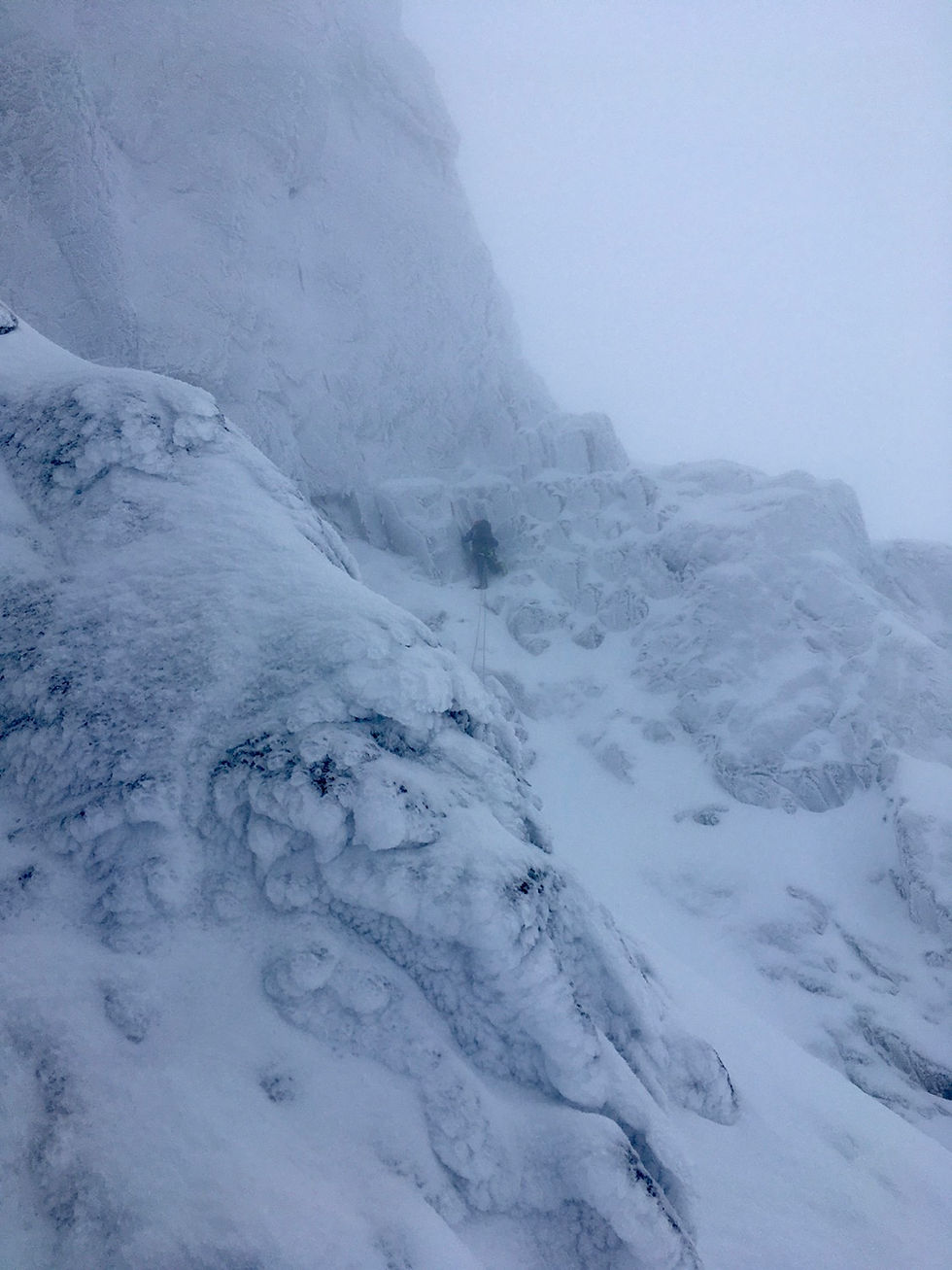Summer series of interest - More challenging routes on the north face of Ben Nevis.
- David Buckett

- Apr 11, 2020
- 6 min read
Updated: Apr 5, 2021
In part 2 of our Ben Nevis interest series through April i will focus upon the North Face of Ben Nevis in summer conditions, focusing upon the classic ridges that can be climbed to reach the summit with handy hints and tips along the way. Hopefully this article will allow you to get inspired and to help determine which route is appropriate for you and your team.
A few aspects that need to be stated first regarding assumptions of how to tackle these routes. Firstly these are mountaineering or scrambling routes rather than walks where for the majority of the ridge climbing equipment will be needed: helmet, harness, ropes, rock gear, to safeguard the party. This is not an article about when, where or how to use this technical equipment. That is your own decision to make based on your experience and knowledge.
Secondly this is not a route description for the Ben Nevis ridges but more of a piece focusing upon the highlights of the routes with some local knowledge thrown in to aid decision making.

North Face of Ben Nevis, taken from the slopes of Carn Mor Dearg.
Very briefly a description of this photo for an overview for this article. The CIC hut is situated just right of centre out of shot, covered by the slopes of Carn Mor Dearg, Far right, not in photo is Castle ridge, right hand side is Ledge Route just right of the streaky snowy bowl of Number 5 gully, just left of centre and the longest ridge is Tower Ridge splitting the 2 main snow areas, far left of the photo is North East buttress, then Observatory ridge is between these 2 ridges coming in at a 45 degree angle onto North East buttress in the shade. The CMD arete is far left off the photo.

The Carn Mor Dearg arete (cmd arete) with North East buttress on the right.
This is the next easiest route after the mountain track but it is a step up from it in terms of personal hill skills and knowledge. Other similar routes would be Striding edge or Crib Goch. If you like the wilder side of the mountains and amazing views into the North Face of Ben Nevis then this is for you. Overall the path is rough and small until the summit of Ben Nevis is reached so good footwork and navigation is needed. Overall the day is longer as the munro summit of Carn Mor Dearg needs to be ascended before the ridge. From the photo above the section of the ridge that you see is about 1km long normally traversed from left to right to ascend Ben Nevis.
The main confusion about this route is the approach descriptions. A lot of guide books and online descriptions have people starting at the Visitor centre in Glen Nevis then walking up the mountain path and to the CIC hut, then taking a straight line up the slope from the hut to the summit of Carn Mor Dearg. Having seen many people do this, it is not a natural line and is pretty horrific, being a steep grassy boulder slope. There is an actual path starting from the North face car park that ascends through the forest to an upper car park and deer fence. Once over the deer fence there is a small branch off the main CIC hut path after about 400m that ascends the west slopes to Carn Mor Dearg, much nicer.
The gallery above shows well the general nature of the frost shattered rocks along most of the ridge with the harder sections as well. A good head for heights and confident footwork is needed and there are options along the ridge to make it harder by staying on the crest as much as possible or there are small by-pass tracks on the east side of the ridge.
The next few routes are on the main north face of Ben Nevis and all start by walking up to the CIC hut situated at around 670m a.s.l. Ledge route was first recorded to be ascended in 1895 in summer and 1897 in winter conditions. Like a lot of mountaineering routes sometimes the trickiest part is finding the start from the CIC hut. There is a lot of broken bouldery ground to cross and lots of small paths going in all directions, care is needed in low cloud to find the correct start and remember that it is a ridge you are supposed to be on and not a gully! Once on the ridge (indicated by a large perched mushroom tower) the trickiest sections come at the start with a narrow section of ridge with a short down climb for a few steps before traversing along another narrow section of ridge. After this area the ridge broadens into shattered boulders where a variety of lines can be taken to make it easier or harder, with the route generally staying to the crest.
At the end of the ridge you finish on the summit of Carn Dearg, a shoulder of Ben Nevis, from here it is roughly half and hour to the summit. Navigating this section is hard in low cloud and it is easy to get lost as there are no paths or features on the ground, even though you are only a few hundred meters from the main mountain path.
The gallery above shows a few photos of the harder section and also the change in visibility that can be encountered.
This is the classic mountaineering route of the north face with many interesting sections along the way with some easy climbing sections as well as unique positions that you find yourself in. This route was first climbed over separate 2 days in 1892 with the first day seeing progress of the party of 3 gain the ridge up to the base of the great tower where they couldn't find a route to progress, so they down climbed back to the start. The day after they walked to the summit and down climbed the top section to link up with where they had finished the previous day, down climbing over sections that we now know of as 'tower gap', 'the chock stone' pitch and the 'eastern traverse'.
Most people use a rope on most or all of this ridge to safe guard themselves. However using the most appropriate technique to balance speed and safety is key, it has been known for teams to spend a night on the ridge for going too slow. This is also coupled with the route finding which, although is not overly complicated (by Skye standards) it does require teams to know their location on the ridge to then plan the correct route choice for the next section. A few common mistakes are assuming that you are further along and the 'little tower' is the 'great tower'. The Little tower is the 1st main climbing section and is not that 'little'. The other error is taking the false eastern traverse to reach the chock stone, a bit more climbing is needed to reach the start of it.
Tower gap also needs to be considered. It is a spectacular position to be on the mountain, at the end of a narrow ridge with a gap in the ridge where you want to progress to that involves about 2 meters of down climbing into the gap and then a short climb out again. The moves down and out are not that obvious or lend themselves to be positive. The best way to approach it is to have a look around for a way down and then just accept that that is what you have to go with. There have been many teams who spend a long time trying to search for a better way and just waist time before just going 'the way'.
If your team has not used a rope to safe guard someone whilst down climbing and making them secure at the bottom, this is worth a practice before you start your day as there is little space and rope faf sucks up lots of time and also confidence in the rope. That all said, if you have a confident team then a pitch down and back up again is the easiest way if the second person is confident down climbing. Or just take a long leap across!
The gallery above shows progress up some of the key areas starting with the little tower, the chock stone, approaching tower gap and then a person in the gap.
The other routes of Castle ridge, North East Buttress and Observatory ridge are all good routes in their own right but are less ascended and there is not enough space to describe them all here.
I hope that this article and photos has given you some inspiration and handy tips to plan your next adventure. If you want more information about the routes or would like to learn the rope techniques to be able to ascend them then please get in contact and we can arrange a day of mountaineering skills. Or have a look at our Ben Nevis Classic ridges page if you would like to be guided up a few of the routes.
We are offering a voucher system at this time, so you can still book your days out in the hills and set a date later on when things go back to normal. For more info about our Covid-19 booking policy please click here.


































Comments